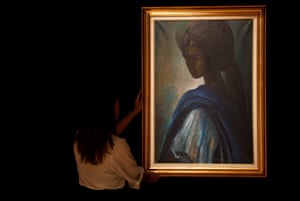
When a long-lost painting depicting a Nigerian princess was found in a modest London flat late last year, art dealers believed the decades-long search had come to an end.
But the hunt for Tutu, as Ben Enwonwu’s 1974 masterpiece and its inscrutable sitter are known, has only just begun.
Tutu is believed to be alive and living in Lagos, the Guardian can reveal after speaking to a cousin of the princess, who is scouring the Nigerian megacity for the woman who has become a national legend.
“We don’t know where she is, but she is still alive,” says Ronke Ademiluyi, speaking over the phone from Lagos. “We’ve been searching for her everywhere.”
Enwonwu painted three portraits of the Ife royal Adetutu Ademiluyi, whom he first saw in Ile-Ife, a town in south-west Nigeria. Struck by her long neck and graceful beauty, Enwonwu spent six months tracking Tutu down, and then had to persuade her family to let her sit for him – something seen as highly irregular for a woman of high birth.
When the first painting was finished, it was worth the effort: Enwonwu regarded it as his masterpiece, capturing the spirit of black emancipation and the Négritude movement he was so passionate about. “He thought she epitomised what he was trying to push about Africa,” says his son, Oliver Enwonwu.
The artist hung the work on his bedroom wall or kept it in a crate under his bed to avoid the temptation to sell it, according to Oliver, who remembers art dealers pretending not to like his father’s paintings in order to persuade him to sell them. Enwonwu would later be filled with regret and was known to chase buyers to the airport, stuffing the money back into their hands and retrieving his work with a sigh of relief.
“His works were like his children,” his son says.
Prints were made of the 1973 Tutu, which now adorn the walls of living rooms across Nigeria, and Enwonwu subsequently painted two more that were sold in an effort to avoid parting with the first. The second version, painted in 1974, was the one discovered in London.
But in 1994, as Enwonwu was dealing with cancer, his house was burgled and the 1973 Tutu was stolen. “He was devastated. It accelerated his death,” says Oliver.
After the robbery, and with the whereabouts of the other two Tutus unknown, all three were considered lost. But that changed when a “perfectly ordinary” family invited Bonhams’ director of modern African art, Giles Peppiatt, to their flat in London in December. On the wall was a picture he had been looking for for a very long time.
“For it to turn up in a modest north London flat is really rather lovely,” says Peppiatt. “That in itself was extraordinary.”
The last time the second Tutu was seen publicly was at an exhibition at the Italian embassy in 1975. After that, the portrait disappeared. Peppiatt discovered that the father of the family in London, a man who had had business interests in Nigeria, had bought it. The family, who wish to remain anonymous, had enjoyed the presence of Tutu for decades without knowing who she was.
The painting will go on sale on Wednesday and is expected to fetch between £200,000 and £300,000. The auction will be broadcast live from London to bidders in Lagos, where the real-life Tutu is believed to be.

“To have even just found the painting was incredibly exciting, in the very modest surroundings in which we discovered it,” says Peppiatt. “But then to find out that the sitter, Tutu, is still alive and living in Lagos – it’s the icing on the cake.”
Ademiluyi’s late father and Tutu were both grandchildren of the Ife king at the time, making them first cousins. That will narrow the search, but not as much as one may think. The former king had 37 wives, and hundreds of children and grandchildren. Princesses, of whom Ademiluy is one, abound.
“The Ademiluyi family is like a clan – there are thousands of us,” she says. “There’s no way we can all know each other.”
Ademiluyi knew nothing of her cousin until she learned about the missing painting. A 98-year-old great-uncle told her Tutu was still alive and in her late sixties, which would fit with her apparent age in the painting.
Oliver Enwonwu says he has heard conflicting accounts of Tutu, one that she was alive and the other that she was dead. He was born while the series was being painted, so he never knew his father’s sitter, but he has long wanted to talk to her. “It will be very exciting if she is still living – it will give context to the painting,” he adds.
In the meantime, he says, his father’s painting should be bought by an institution that will display it to the Nigerian public, although the country has no museum of modern art, despite having produced many great artists.
Peppiatt agrees. “She is of great importance to Nigeria,” he says. “I really hope she goes home.”
Source:-.theguardian



